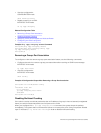
INTERFACE mode
ip igmp query-interval
• Adjust the maximum response time.
INTERFACE mode
ip igmp query-max-resp-time
• Adjust the last member query interval.
INTERFACE mode
ip igmp last-member-query-interval
Adjusting the IGMP Querier Timeout Value
If there is more than one multicast router on a subnet, only one is elected to be the querier, which is the
router that sends queries to the subnet.
1. Routers send queries to the all multicast systems address, 224.0.0.1. Initially, all routers send queries.
2. When a router receives a query, it compares the IP address of the interface on which it was received
with the source IP address given in the query. If the receiving router IP address is greater than the
source address given in the query, the router stops sending queries. By this method, the router with
the lowest IP address on the subnet is elected querier and continues to send queries.
3. If a specified amount of time elapses during which other routers on the subnet do not receive a
query, those routers assume that the querier is down and a new querier is elected.
The amount of time that elapses before routers on a subnet assume that the querier is down is the other
querier present interval.
• Adjust the other querier present interval.
INTERFACE mode
ip igmp querier-timeout
Configuring a Static IGMP Group
To configure and view a static IGMP group, use the following commands.
Multicast traffic for static groups is always forwarded to the subnet even if there are no members in the
group.
Static groups have an expiration value of Never and a Last Reporter value of CLI, as shown in the example
in Viewing IGMP Groups.
• Configure a static IGMP group.
INTERFACE mode
ip igmp static-group
• View the static groups.
EXEC Privilege mode.
show ip igmp groups
392
Internet Group Management Protocol (IGMP)


















